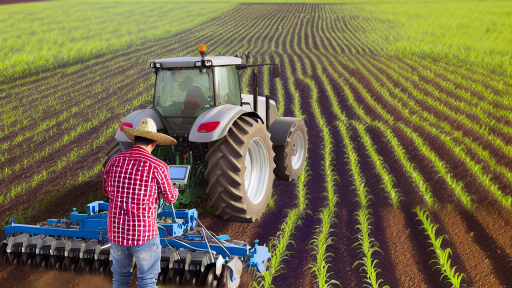Introduction to Agricultural Financial Aid
Agricultural financial aid plays a crucial role in supporting farmers.
This assistance helps in maintaining viable farming operations.
Many farmers face financial challenges due to various factors.
Weather patterns, market fluctuations, and rising costs affect profitability.
Consequently, understanding financial aid options is essential.
Importance of Financial Aid in Agriculture
Financial aid ensures farmers can sustain their livelihoods.
This support contributes to food security for communities.
Moreover, it fosters growth within the agricultural sector.
Investment in farming leads to better production outcomes.
Additionally, financial aid often encourages innovation and sustainability.
Overview of Financial Aid Options
Farmers have access to various financial aid programs.
These options include grants, loans, and subsidies.
Each program offers distinct benefits and requirements.
For instance, grants provide non-repayable funds.
Conversely, loans must be repaid over time.
Transform Your Agribusiness
Unlock your farm's potential with expert advice tailored to your needs. Get actionable steps that drive real results.
Get StartedTypes of Grants
Several government and private organizations provide grants.
These grants target specific projects and initiatives.
For example, conservation grants promote eco-friendly practices.
Loan Programs
Loan programs enable farmers to access necessary capital.
Many of these loans feature low interest rates and flexible terms.
Government-backed loans are prevalent in agricultural financing.
Subsidies
Subsidies reduce the cost burden on farmers.
They often cover specific crops or regions to promote equity.
Farmers must meet certain criteria to qualify for these benefits.
Types of Financial Aid: Grants, Loans, and Subsidies
Grants
Grants provide funds that do not require repayment.
These financial aids support specific projects or needs.
Government agencies and private organizations often offer them.
For instance, the USDA offers grants for various agricultural purposes.
Eligible applicants include farmers, ranchers, and agricultural organizations.
Grants can be competitive, requiring a solid proposal.
Furthermore, they often focus on sustainability and innovation.
Loans
Loans provide capital that must be repaid over time.
They typically come with interest rates that vary based on the lender.
Financial institutions and government programs offer agricultural loans.
The Farm Service Agency provides loans to farmers with limited resources.
These loans can finance equipment, livestock, or land purchases.
Repayment terms usually reflect the borrower’s financial situation.
Moreover, credit history can impact loan approval and interest rates.
Subsidies
Subsidies lower the cost of production for farmers.
Showcase Your Farming Business
Publish your professional farming services profile on our blog for a one-time fee of $200 and reach a dedicated audience of farmers and agribusiness owners.
Publish Your ProfileThe government typically provides these financial supports.
They may come in the form of direct payments or tax breaks.
Subsidies aim to stabilize market prices for certain crops.
Crops like corn and soybeans often receive significant subsidies.
Additionally, these financial aids encourage domestic production.
Farmers must meet specific criteria to qualify for subsidies.
Choosing the Right Option
Selecting the best financial aid option is crucial for success.
Farmers should assess their specific needs and repayment capabilities.
Moreover, understanding the requirements of each option is essential.
They should consider long-term goals and project viability.
Engaging with financial advisors can provide valuable insights.
Finally, applying early increases the chances of securing aid.
Eligibility Criteria for Agricultural Financial Aid Programs
Overview of Eligibility Requirements
Eligibility for agricultural financial aid programs varies widely.
Farmers must meet specific criteria to qualify for assistance.
This ensures that aid reaches those who need it most.
Farm Size and Type Considerations
The size of the farm often plays a critical role in eligibility.
Many programs have minimum acreage requirements.
Moreover, some programs target specific types of farming.
Diversified farms might qualify for different assistance than monoculture farms.
Income Levels and Financial Stability
Income levels significantly affect eligibility for financial aid.
Programs typically assess the farmer’s overall financial situation.
Low-income farmers often receive priority for grants and loans.
Stable financial history may also enhance eligibility for certain programs.
Geographic Location Requirements
Geographic considerations are essential for determining eligibility.
Some programs are region-specific and target local farming issues.
Additionally, climate conditions can affect the types of aid available.
Compliance with Regulatory Standards
Farmers must comply with various regulatory standards.
Adherence to environmental laws is often necessary for eligibility.
Programs may require proof of sustainable practices and crop management.
Application Process and Documentation
The application process can be complex and requires careful preparation.
Farmers need to gather the necessary documentation to apply.
This might include financial statements and compliance records.
Accurate and complete applications increase the chances of approval.
Learn More: Common Mistakes When Applying for Farm Aid
How to Apply for Financial Aid
Gather Necessary Documentation
Begin by collecting all relevant documents needed for your application.
Gather financial statements from your farming operations.
Ensure you have tax returns for the past few years.
Additionally, collect information on any existing loans or debts.
Identify Eligible Programs
Research various financial aid programs available for farmers.
Consider options like grants, low-interest loans, and subsidies.
Showcase Your Farming Business
Publish your professional farming services profile on our blog for a one-time fee of $200 and reach a dedicated audience of farmers and agribusiness owners.
Publish Your ProfileEach program has specific eligibility criteria to review.
Complete the Application Form
Access the application form for your chosen program online.
Fill in your personal and business information precisely.
Provide honest financial data to avoid complications.
Submit Your Application
Review your application thoroughly before submission.
Double-check all attachments and supplementary documents.
Submit the application by the specified deadline.
Follow Up on Your Application
After submission, keep track of your application status regularly.
Contact program administrators if you have any questions.
Be prepared to provide additional information if requested.
Find Out More: Financial Assistance Resources for New Farmers
Understanding Federal vs. State Financial Aid Options
Overview of Financial Aid Sources
Farmers can seek financial aid through federal and state programs.
Each option has unique benefits and eligibility criteria.
Understanding the differences is crucial for optimizing support.
Federal Financial Aid Opportunities
The federal government offers various financial aid programs for farmers.
The USDA plays a central role in administering these programs.
One major program is the Farm Service Agency (FSA) loan program.
FSA loans are available for working capital, equipment purchases, and land acquisition.
Additionally, grants and subsidies help support sustainable agricultural practices.
Types of Federal Programs
Farmers can apply for several types of federal assistance programs.
- Direct loans and guaranteed loans through the FSA.
- Crop insurance programs to mitigate risk.
- Research and development grants for innovative practices.
State Financial Aid Programs
States also provide financial assistance tailored to local agricultural needs.
State programs often complement federal initiatives.
Each state’s agriculture department manages these programs.
Farmers should explore options available in their specific state.
Key State-Level Programs
State financial aid programs can vary widely.
- Loan programs for beginning farmers with favorable terms.
- Grants for conservation practices and environmental enhancements.
- Local initiatives that support specific crops or livestock.
Eligibility and Application Process
Eligibility for federal and state aid can differ based on funding sources.
Farmers must gather necessary documentation before applying.
Applications often require detailed financial statements and projected budgets.
Grant applications may ask for sustainability plans or community impact assessments.
Combining Federal and State Resources
Farmers can benefit greatly by utilizing both federal and state resources.
Combining these sources can increase funding potential.
This strategy often provides a more comprehensive support system.
It is essential to remain aware of application deadlines for each program.
Staying Informed
Staying updated on funding opportunities is crucial.
Farmers should regularly check USDA and state agriculture department websites.
Networking with local agricultural organizations can uncover additional resources.
Participating in workshops or seminars can provide valuable insights.
See Related Content: Comparing Different Farm Subsidy Programs

Impact of Financial Aid on Sustainable Farming Practices
Enhancing Financial Stability
Financial aid directly enhances the stability of farming operations.
It allows farmers to invest in sustainable technologies.
Showcase Your Farming Business
Publish your professional farming services profile on our blog for a one-time fee of $200 and reach a dedicated audience of farmers and agribusiness owners.
Publish Your ProfileAs a result, farmers can adopt practices that benefit the environment.
Moreover, financial support minimizes the impact of market fluctuations.
Encouraging Innovative Practices
Access to funds encourages farmers to try new techniques.
For instance, they can implement crop rotation more effectively.
Additionally, farmers can explore organic farming methods.
Transitioning to innovative practices can improve yields and quality.
Promoting Environmental Stewardship
Financial aid often incentivizes environmentally friendly practices.
Programs may provide grants for installing irrigation systems.
These systems reduce water waste and enhance efficiency.
Furthermore, funds may support soil conservation initiatives.
Building Community Resilience
Financial aid strengthens community support networks among farmers.
Collaborative projects become feasible, promoting shared resources.
In turn, this enhances local food systems and sustainability.
Communities develop resilience against climate-related challenges.
Improving Access to Education and Resources
Financial assistance often provides access to training and education.
Farmers learn best practices for sustainable farming.
Workshops and courses help improve management skills.
Increased knowledge leads to better decision-making on the farm.
Facilitating Research and Development
Financial aid can fund research in sustainable agriculture.
These research projects address specific regional challenges.
They create solutions tailored to local environmental conditions.
Consequently, farmers can adopt practices backed by scientific evidence.
See Related Content: Steps to Secure Financial Aid for Your Farm
Common Challenges in Securing Agricultural Financial Aid
Understanding the Landscape
Agricultural financial aid can be complex and challenging to navigate.
Farmers often face numerous obstacles when seeking assistance.
Each funding source has its own set of rules and requirements.
Additionally, applicants must be aware of various deadlines.
Navigating the Application Process
The application process can often be overwhelming for farmers.
Many programs require detailed documentation and financial records.
Moreover, formatting requirements can vary significantly.
This inconsistency adds to the stress of securing aid.
Understanding Eligibility Requirements
Eligibility for financial aid presents another challenge.
Different programs target specific types of agriculture or business sizes.
Farmers must carefully review these criteria before applying.
Failure to meet requirements can result in denied applications.
Accessing Information and Resources
Finding accurate information about available funding can be difficult.
Many farmers rely on local agricultural extensions for guidance.
However, not all regions offer the same level of support.
This discrepancy can lead to missed opportunities for financial aid.
Competing with Other Applicants
Competition for funding can be intense in many regions.
Showcase Your Farming Business
Publish your professional farming services profile on our blog for a one-time fee of $200 and reach a dedicated audience of farmers and agribusiness owners.
Publish Your ProfileFarmers often vie for limited resources against one another.
Proposals must stand out to increase chances of approval.
Consequently, effective communication of needs is crucial.
Long Processing Times
Appreciating the time required for application processing is vital.
Farmers may wait weeks or months for decisions on their applications.
During this time, financial strain may intensify for some.
Planning for potential delays is essential for farm sustainability.
Resources for Finding Financial Aid
Government Programs
Various government programs offer financial aid to farmers.
The Farm Service Agency (FSA) provides loans and grants.
These funds assist farmers facing financial challenges.
Additionally, the U.S. Department of Agriculture (USDA) features numerous programs.
These programs include grants for sustainable practices and disaster relief.
Nonprofit Organizations
Several nonprofit organizations focus on agricultural support.
The National Farmers Union advocates for farmers’ rights and assistance.
Furthermore, groups like Farm Aid provide financial aid and resources.
They help farmers affected by market variability or natural disasters.
Online Resources
Numerous websites offer valuable information on financial aid options.
For instance, USDA’s website includes extensive resources and guidance.
Additionally, the National Sustainable Agriculture Coalition provides insights.
They focus on funding opportunities for sustainable practices.
State Programs
Many states administer their financial assistance programs.
These programs often cater to local agricultural needs.
Such assistance includes grants for conservation efforts.
Check your state’s agriculture department website for details.
Financial Institutions
Local banks and credit unions frequently offer specialized farmer loans.
Some institutions feature programs tailored specifically for agriculture.
Contact financial institutions to explore possible funding options.
Additionally, agricultural cooperatives may provide support.
Additional Resources
Risk in Agriculture – USDA ERS
AREC – Agricultural and Resource Economics | University of …




